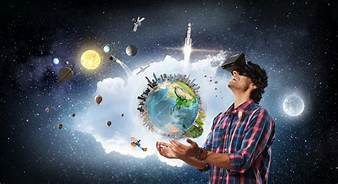Augmented and Virtual Reality is cool! I am talking about the jaw dropping, “I can’t believe they can do that, how can we apply this and I want it now” type of awesomeness. BUT…
AR and VR are not for everyone and everything.
As someone who lives learning technology, I am going to have a hard time picking between the 10+ sessions at DevLearn 2019 dedicated to AR/VR and emerging tech including the keynote, “Augmented Human: How Technology Is Shaping the New Reality” with Dr. Helen Papagiannis.
AR & VR… what is it good for?
AR & VR have been around for a while, but it wasn’t until the last few years that it went from novelty to necessity and from leisure to business use. I remember about 5+ years ago, my husband (not a tech guy) got us all VR Goggles for use with our Samsung phones. It was fun for a bit seeing the view from the top of the Empire State Building and “flying” across the Great Plains all while sitting by the fire in our family room.
Flash forward just a few years and now AR & VR are seemingly everywhere… but should it be?
We all want to be on the cutting edge of learning, making the best use of emerging tech, creating content and interactions that deliver information and help learners retain and employ that information. Learning technology is helping us every day get better, faster, and more effective at developing, delivering learning. But it needs to be right for the topic and the learner and it can’t be the only way you deliver.
Just like arbitrary requests for training from stakeholders and business leaders – because training fixes everything – yeah right! Just because it is new and cool doesn’t mean it is right for your training initiative. What L&D professional hasn’t been asked “Hey, can we use AR & VR for that training course?”
Great uses for AR & VR:
-
- Design Engineering – Overlaying a schematic on an existing structure or foundation to pinpoint potential design or structural issues.
- Hazard Training – Demonstrating how to triage or resolve issues that may be hazardous or dangerous if done IRL (in real life).
- Biotech/Medical Device Training – Demonstrating the use of new medical devices without endangering patients.
Not so great uses for AR & VR:
-
- Communication Skills – Participants in two locations, put on some goggles and practiced communication in virtual reality with the help of a facilitator. Soft skills are best kept IRL.
- Technical Training – An AR game was created to “demonstrate” the software development lifecycle at a company and was made competitive through levels and rewards. Although this was probably fun for the learners, spend less time on process and more on the doing.
And now for just a few of the challenges:
- AR & VR doesn’t work for everyone due to vision, inner ear and other medical conditions.
- It takes a long time to develop – 1 month to 1 year or more from concept to ready.
- Just because it is new does not make it the solution to your training problem.
Pick your topics and initiatives! Consider your learner and make AR & VR one of the solutions, not the only solution.

